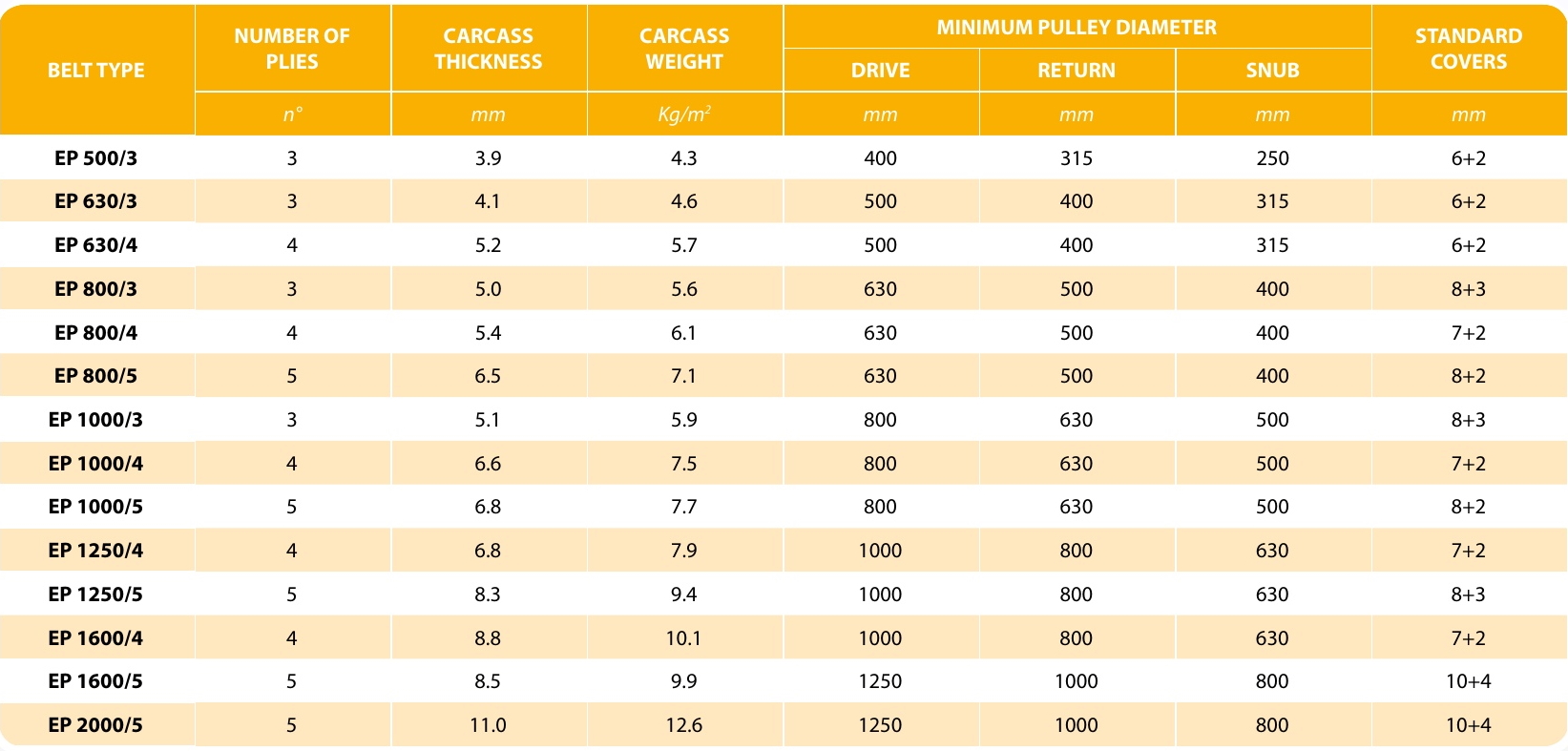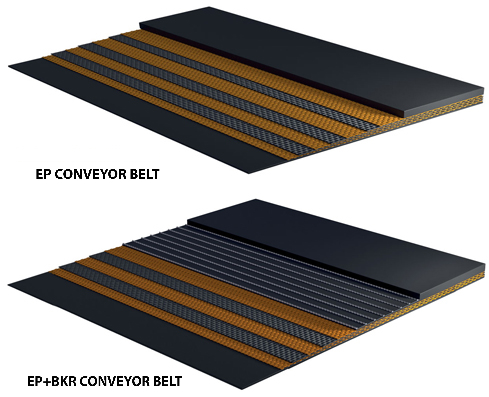 EP belts with reinforcement feature a specific high-strength core with differentiated structure composed of warp polyester and weft nylon fabric. This is the “optimum” structure for the working conditions of the belt: high-strength and low-elongation weave in the lengthwise direction, impervious to weather and, above all, to moisture.
EP belts with reinforcement feature a specific high-strength core with differentiated structure composed of warp polyester and weft nylon fabric. This is the “optimum” structure for the working conditions of the belt: high-strength and low-elongation weave in the lengthwise direction, impervious to weather and, above all, to moisture.
The nylon weft in the crosswise direction offers excellent flexibility for highly concave supporting stations and ensures exceptional impact resistance even from large-size falling materials.
The EP code is followed by a set of digits that indicate the strength class, identified by the nominal value of the carcass tensile strength combined with the number of plies that compose it, for example EP 630/4
FLEXIFER® belts are used in all industrial sectors to convey mediumheavy cold and chemically inert materials.
They find uses in the iron and steel industry, mining industry, cement industry, concrete mixing equipment, foundries, glassworks, etc.
FLEXIFER® belts are produced with cut edges.
Standard covers: N, Y (see cover table)
a textile carcass belt.
They are used to convey particularly abrasive, cutting and large- size materials, even with very long center distances.
Application fields include the iron and steel industry, mining, even when self-extinguishing and anti-static properties are required, cement industry, glassworks, etc.
NOMAFER® belts are produced with molded edges.
Standard covers: W, Y, X, K, S, GS (see cover table)
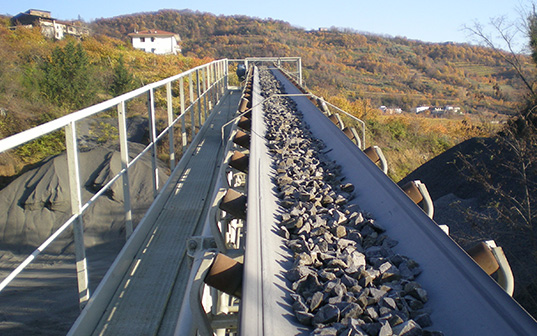
These belts are used to convey petroleum coke, asphalt concrete, complex fertilizers processed with oils, glass scrap impregnated with oil, municipal solid waste, oil seeds, feeds, etc.
OLIFLEXIFER® belts are produced with molded edges.
Standard covers: MOR, OR (see cover table)
PIROFLEXIFER® belts are used for high temperature, acid and alkali resistance. The series includes three types for use at different operating temperatures:
- HR-130: max. temperature 130°C
- HR-150: max. temperature 150°C
- HR-180: max. temperature 180°C
These belts are used to convey coke, clinker, hot steel agglomerates, roasted minerals, acid superphosphates, sulfur, etc.
PIROFLEXIFER® belts are produced with molded edges.
Standard covers: HR-130, HR-150, HR-180; (see cover table)
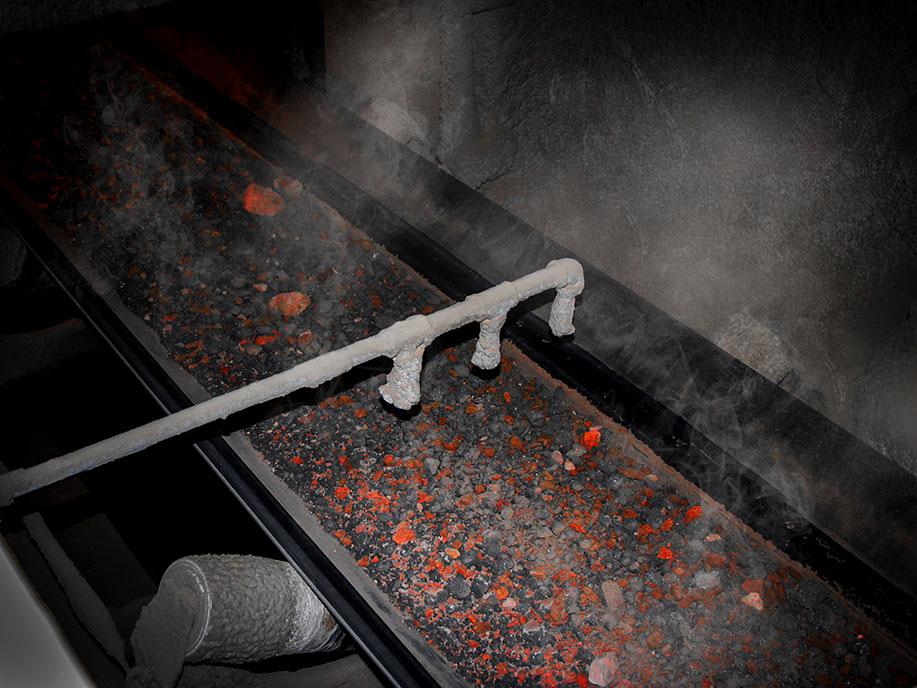
The series includes two types for use at different operating temperatures:
HR-220:
- temperature on the belt surface: 220°C
- maximum material temperature: 300° C
HR-300:
- temperature on the belt surface: 300°C
- maximum material temperature: 500°C
They are primarily used in the iron and steel industry to convey sinter
and in the cement industry to convey clinker as well as in all other
situations where the material is extremely hot.
SUPERPIROS® belts are produced with molded edges.
Standard covers: HR-220, HR 300 (see cover table)
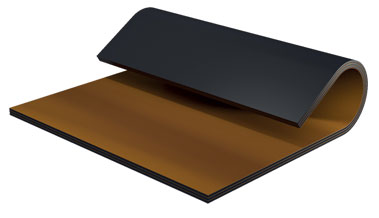
FLEXIFLAT® belts have a low friction coefficient fabric on the bottom surface making them suitable for mounting on conveyors with sliding surfaces.
They are produced with high-strength polyester fabrics in monofilament weft for high transverse rigidity and perfect running straightness.
They are a good alternative to PVC belts due to their high abrasion and weather resistance. They are used in the waste recycling industry, wood industry, ceramics industry, etc.
FLEXIFLAT® belts are produced with cut edges.
Standard covers: N, HR-150, MOR, OR; (see cover table)
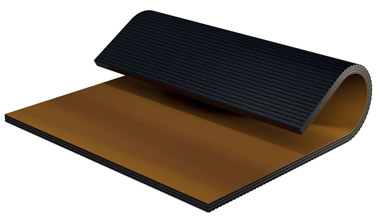
GRIFLEX® belts feature a special rough top surface. They have good abrasion, tear and weather resistance.
They are generally used for inclined conveyance of bulk and packaged products.
Maximum slope angle for inclined conveyance: 35°
GRIFLEX® belts are produced with cut edges.
Standard covers: N, MOR; (see cover table)
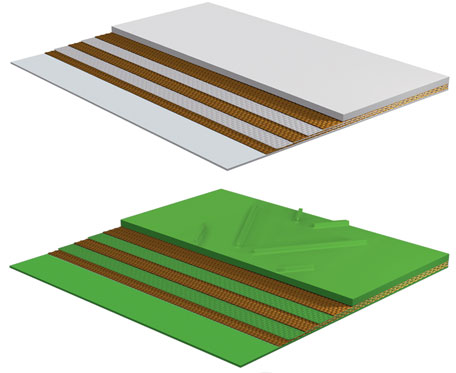
ALIFLEXIFER® belts find many uses, including the agri-food industry where foods for human consumption are governed by directives to prevent contamination of the products carried by the belt. ALIFLEXIFER® belts meet FDA requirements.
These belts are manufactured in white or green and can also be used in the ceramics industry as well as to transport sugar, salt, rice, grain, olives, etc. ALIFLEXIFER® belts are made with cut edges and can be made with CHEVRON profiles; (see cover table)
ALIFLEXIFER® belts are also made for vertical material transport.
EP belts with reinforcement feature a specific high-strength core with differentiated structure composed of warp polyester and weft nylon fabric. This is the “optimum” structure for the working conditions of the belt: high-strength and low-elongation weave in the lengthwise direction, impervious to weather and, above all, to moisture.
The nylon weft in the crosswise direction offers excellent flexibility for highly concave supporting stations and ensures exceptional impact resistance even from large-size falling materials.
The EP code is followed by a set of digits that indicate the strength class, identified by the nominal value of the carcass tensile strength combined with the number of plies that compose it, for example EP 630/4

FLEXIFER®
FLEXIFER® belts are used in all industrial sectors to convey mediumheavy cold and chemically inert materials.
They find uses in the iron and steel industry, mining industry, cement industry, concrete mixing equipment, foundries, glassworks, etc.
FLEXIFER® belts are produced with cut edges.
Standard covers: N, Y (see cover table)
NOMAFER®
a textile carcass belt.
They are used to convey particularly abrasive, cutting and large- size materials, even with very long center distances.
Application fields include the iron and steel industry, mining, even when self-extinguishing and anti-static properties are required, cement industry, glassworks, etc.
NOMAFER® belts are produced with molded edges.
Standard covers: W, Y, X, K, S, GS (see cover table)

OLIFLEXIFER®
OLIFLEXIFER® belts are used where there is a need for outstanding characteristics of resistance to the aggressive action of mineral, vegetal and animal oils and greases. They ensure excellent resistance to aliphatic and aromatic solvents as well as good resistance to abrasion and tear.
These belts are used to convey petroleum coke, asphalt concrete, complex fertilizers processed with oils, glass scrap impregnated with oil, municipal solid waste, oil seeds, feeds, etc.
OLIFLEXIFER® belts are produced with molded edges.
Standard covers: MOR, OR; (see cover table)
PIROFLEXIFER®
PIROFLEXIFER® belts are used for high temperature, acid and alkali resistance. The series includes three types for use at different operating temperatures:
- HR-130: max. temperature 130°C
- HR-150: max. temperature 150°C
- HR-180: max. temperature 180°C
These belts are used to convey coke, clinker, hot steel agglomerates, roasted minerals, acid superphosphates, sulfur, etc.
PIROFLEXIFER® belts are produced with molded edges.
Standard covers: HR-130, HR-150, HR-180 (see cover table)

SUPERPIROS®
SUPERPIROS® belts are the worldwide top-of-the-range belts for conveying very hot materials. They also feature excellent abrasion resistance.
The series includes two types for use at different operating temperatures:
HR-220:
- temperature on the belt surface: 220°C
- maximum material temperature: 300° C
HR-300:
- temperature on the belt surface: 300°C
- maximum material temperature: 500°C
They are primarily used in the iron and steel industry to convey sinter
and in the cement industry to convey clinker as well as in all other
situations where the material is extremely hot.
SUPERPIROS® belts are produced with molded edges.
Standard covers: HR-220, HR 300; (see cover table)
FLEXIFLAT®

FLEXIFLAT® belts have a low friction coefficient fabric on the bottom surface making them suitable for mounting on conveyors with sliding surfaces.
They are produced with high-strength polyester fabrics in monofilament weft for high transverse rigidity and perfect running straightness.
They are a good alternative to PVC belts due to their high abrasion and weather resistance. They are used in the waste recycling industry, wood industry, ceramics industry, etc.
FLEXIFLAT® belts are produced with cut edges.
Standard covers: N, HR-150, MOR, OR (see cover table)
GRIFLEX®

GRIFLEX® belts feature a special rough top surface. They have good abrasion, tear and weather resistance.
They are generally used for inclined conveyance of bulk and packaged products.
Maximum slope angle for inclined conveyance: 35°
GRIFLEX® belts are produced with cut edges.
Standard covers: N, MOR (see cover table)
ALIFLEXIFER®

ALIFLEXIFER® belts find many uses, including the agri-food industry where foods for human consumption are governed by directives to prevent contamination of the products carried by the belt. ALIFLEXIFER® belts meet FDA requirements.
These belts are manufactured in white or green and can also be used in the ceramics industry as well as to transport sugar, salt, rice, grain, olives, etc. ALIFLEXIFER® belts are made with cut edges and can be made with CHEVRON profiles; (see cover table)
ALIFLEXIFER® belts are also made for vertical material transport.



